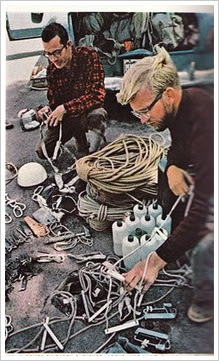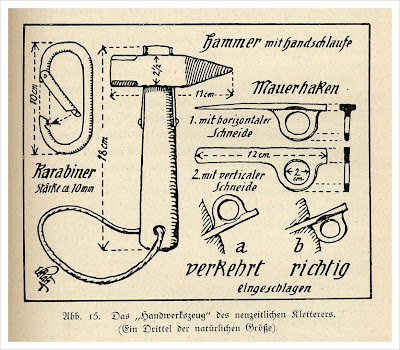The pilot seems a good sort. Every now and then I am awakened from my West bound slumber as the intercom sings nasally and he points out various geographic features sliding by below the wing.
We are taking the southern route to LAX and It is over the redness of Utah that I hear the familiar names: Zion, Arches, Capitol Reef, Moab.. I am knocked back twenty years. Hair longer (and thicker) we came to the desert spires looking for dizzying exposure, solitude, and the tracks of the greats that pioneered these routes. What we found on the
Fisher Towers was something else entirely.
 | |
| Titan |
 |
| 1st ascencionists Hurley, Kor and Ingalls May 1962 | | | | | | | | |
|
| |
 | |
| Summit |
|
|
|
From afar the towers pulse with an otherworldly redness in response to the afternoon sun. I have always been blown away by the play of light over rock-To this day I am inexplicably drawn to the towers of the Dolomites in the peaks around
Cortina when visiting our Italian workshop. Our fabric pattern choices are easily a result of colours that our travels have ingrained in us. Still- When we looked upon the Titan I was yet to fill my head with things such as warp, weft, canvasing, and surgeons cuffs. I just new I liked the colours....
Our stomachs knot as we gaze upwards into the vastness of the heights. Packs, crammed with seemingly every bit of climbing gear we own, seem woefully inadequate. We wanted air beneath our heels but 900 feet of exposure seems overwhelming in the flatness of the desert.
 |
| a rack of many colours |
 |
| racking up for the 1st ascent |
Up close the soaring towers seem a mirage. They appear to be falling down around us and the recent rains give the mud covered sandstone the appearance of African termite mounds.
 |
| The Finger of Fate |
We fall into a fitful sleep after too many cheap beers. The towers looming above and beyond the tent walls and our minds.
 |
| a room with a view |
 |
| Kor on the sharp end of the rope. "The Skull" hangs above the Finger of Fate |
|
The Titan is more alpine route than a desert climb. One is forced to draw on everything from the bag of tricks. The crumbling mud is a mercurial surface to tread upon. There are tales of parties using ski poles, ice tools, and golf clubs to supplement the usual wall climbers rack. As one moves carefully on what anywhere else would be termed choss there is the head reeling and stomach tugging pull of exposure. The desert floor seems to beckon as gravity implores your body to leave this place. Evidence of climbs between the 1st ascent of 1962 and today are strewn across a vertical plane as one is forced to contend with anchors that surely were placed by the 1st party. A reliance on 40 year old manky pitons leaves us shaking as we move above placements and look for purchase in the muddy seams. We are scared and screaming at one another as an outlet. We know we are in above our heads.
 |
| mank |
 |
| old & the new |
 |
| old piton & mud |
 |
| early tools of the trade |
 |
| correct placement |
While archaic looking the old gear holds (barely) and we find ourselves moving into that rarefied space where connection with the horizontal ceases and the vertical takes hold. Once past an early traverse, the door is shut and our commitment becomes real. This is what you come for. The feeling of slipping the moorings and being cast adrift on a seemingly endless vertical sea. We have become voyagers and fall into rhythms as the ground fades away. Both following and leading we move ever upwards. We work diligently and at times in silence.
 |
| adrift |
At days end we are aching and hollow, the ammonia smell of fear mixed with the dustiness of sandstone. Our mouths are dry, voices croak from yelling across too many rope lengths. We rap our fixed lines in the dark, headlamps casting mean pools into the void of the descent gully. As we stumble through the brush we feel the first drops of returning rain. A rain that will leave us tent bound for days and turn the grand towers into cascading rivers of mud.
There is unfinished business outside of Moab. Perhaps it's better that way. I drift back to sleep still feeling the place within as the plane's hum leaves the desert in its contrail.
Everything seems just moments ago as we descend into the L.A. basin.
E.M.M.
1st ascent pictures courtesy of National Geographic November 1962.



























